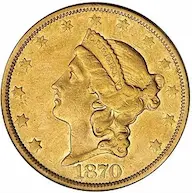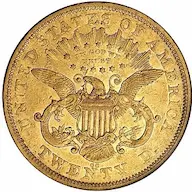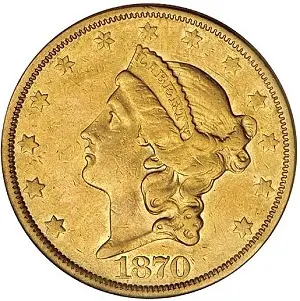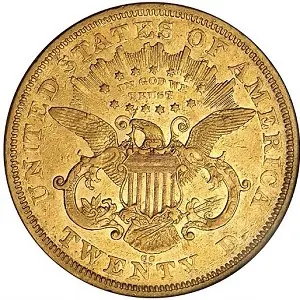1870-CC Coronet $20 Double Eagle
In 1859, a prospector named Henry Comstock staked a claim on the eastern slope of Mount Davidson (present day Storey County, Nevada), the spot where fabulous gold and silver reserves were later found.
The discovery, dubbed the Comstock Lode, brought thousands of miners to the region, touching off a veritable bonanza.(1) (The word "bonanza" may conjure up old-timer memories of the Cartwright family from the classic TV show! The Ponderosa Ranch was less than a day's ride from the mines.)
History books are replete with exploits of the fabled finding, and to be sure, was an important factor in the settlement of the American West. Prominent in those rough and tumble times was the development of Carson City.
Founded in 1858 by Abe Curry, Carson City's growth accelerated dramatically as an important mining hub while precious metal ore was being unearthed nearby. The prosperous boomtown was selected as the state capital when Nevada joined the Union in 1864.
Most of the riches were shipped over the Sierra Nevada Mountains to the U.S. branch mint operating in San Francisco, and then back again after being converted to coinage. Because this practice was very expensive and risky, Comstock Lode miners petitioned Congress for a new branch mint in their vicinity.
Legislation to establish a mint in Nevada was approved on March 3, 1863, but there were many obstacles that slowed construction of the facility. It wasn’t until January 1870 when the "CC" Mint finally opened for business, thus beginning a magnificent American numismatic legacy.
Abe Curry, who was named the facility’s superintendent, once promised that "$20 gold pieces would be as plentiful as blackberries" as soon the Carson Mint commenced operations. Curry must have been disappointed when his team struck a measly 3,789 double eagles during their inaugural year.(2)
There were a couple of reasons why the output of 1870-CC double eagles was so small. First of all, the Carson City budget did not include much of a bullion fund, forcing gold and silver depositors to undergo a long wait while their consignments were processed and converted into coins (had a bullion fund been in place, the Mint would have been able to maintain a supply of previously struck coins available for immediate payout). Despite vast amounts of ore being uncovered just a few miles away, many miners preferred to continue sending their yields to San Francisco.(3)
Secondly, of those deposits that were dropped off at the local mint, most of them were refined into gold and silver bars rather than coins, in accordance with the wishes of the miners.(4)
Since there are no extant Mint State specimens of the 1870-CC double eagle, it is logical to assume the entire smallish mintage was released into circulation, where 99% of them eventually vanished.(5)
Many years passed before collectors started taking the 1870-CC seriously. In 1911, an example described as “Fine” sold for $24.50, barely eclipsing the coin’s face value. Four years later, another “Fine” specimen generated a bid for just $23.50.(6) After the Gold Recall of 1933, the price of the 1870-CC, along with many other rare gold coins, finally began to pick up steam.(7)
Today, the 1870-CC double eagle is recognized as the “King of Carson City Gold.” Collectors compete fiercely to claim ownership of an 1870-CC twenty, for few coins carry such a distinguished legacy in one bundle: extreme rarity, the glamor of gold, a beautiful design, and the romanticism of the Carson City Mint.(8)
| Estimated survivors in all grades: 41 ?
The survivor estimate from PCGS represents an average of one or more experts' opinions as to how many examples survive of a particular coin in all grades. Survival estimates include coins that are raw, certified by PCGS, and certified by other grading services. Learn more at PCGS. |
| PCGS Rarity Scale: 8.6 ?
The 'PCGS CoinFacts Rarity Scale' assesses the relative rarity of all U.S. coins, based on estimated surviving examples. The scale runs from 1.0 to 10.0. The higher the number, the rarer the coin.
Learn more at PCGS. |
| Search for the 1870-CC Coronet $20 Double Eagle on eBay** |
Preview of eBay selection (extremely rare and valuable coins like the 1870-CC $20 are seldom found for sale, but go ahead and give it a look!):
 |
 |
| Trendline Avg = 41.05 | BEST |
 |
 |
| Trendline Avg = 41.05 | BEST |
Historic Value Trend Charts:
| Last updated 10-14-25 | Return to Key Date Coin List | |
| Compare to Common Date Coin of Same Type | ||
|
|
||
| Download Charts to Your Computer | ||
Sources
1. Goe, Rusty. The Mint on Carson Street. Reno, NV: Southgate Coins, 2004
2. Stack's Bowers Galleries. 1870-CC Liberty Double Eagle. Aug 2012 Auction.
3. Heritage Auctions. 1870-CC $20. Feb 2023 Auction.
4. Heritage Auctions. 1870-CC $20. Oct 2022 Auction.
5. PCGS. 1870-CC $20 (Regular Strike).
6. Heritage Auctions. 1870-CC $20. Oct 2022 Auction.
7. Heritage Auctions. 1870-CC $20. Feb 2023 Auction.
8. Garrett, Jeff and Guth, Ron. 100 Greatest U.S. Coins, 5th ed. Pelham, AL: Whitman Publishing, 2019.
**Many very fine coin dealers sell on eBay. At any point in time, there may be over one million search results for United States coins. This includes quite a few of the recommendations on our Key Date Coin List.
If you’re thinking about purchasing a rare coin, eBay is certainly worth a look. For your convenience, the links from this site to eBay are coded to bring up only coins certified by PCGS and NGC.
As is always, always the case, never buy a valuable coin from a seller whose trustworthiness cannot be verified. Learn more about this at our chapter Best Places to Buy Coins, which also has a section on doing business on eBay.
In the interest of full disclosure, Rare Coins 101 receives a small commission anytime someone connects to eBay from this site and purchases something.
Coin images by Stack's Bowers Galleries.


